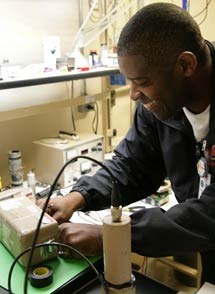
Handy Links
SLAC News Center
SLAC Today
- Subscribe
- Archives: Feb 2006-May 20, 2011
- Archives: May 23, 2011 and later
- Submit Feedback or Story Ideas
- About SLAC Today
SLAC News
Lab News
- Interactions
- Lightsources.org
- ILC NewsLine
- Int'l Science Grid This Week
- Fermilab Today
- Berkeley Lab News
- @brookhaven TODAY
- DOE Pulse
- CERN Courier
- DESY inForm
- US / LHC
SLAC Links
- Emergency
- Safety
- Policy Repository
- Site Entry Form

- Site Maps
- M & O Review
- Computing Status & Calendar
- SLAC Colloquium
- SLACspeak
- SLACspace
- SLAC Logo
- Café Menu
- Flea Market
- Web E-mail
- Marguerite Shuttle
- Discount Commuter Passes
-
Award Reporting Form
- SPIRES
- SciDoc
- Activity Groups
- Library
Stanford
Around the Bay
People: Eddie McGee Makes Sure Safety Counts
It's a Tuesday morning, and radiological instrumentation specialist Eddie McGee has one of his charges on the examination table. An angle-poised lamp shines down on the patient, an unassuming tan metal box about the size of two stacked bricks. It's a handheld field radiation detector; the lid is open and a few wires poke out. As McGee probes for faults, he talks to the device as if it were a cranky child squirming at the touch of a cold stethoscope. Finally the device chirps—one of its internal detectors, sensitive to electrons and gamma radiation, registers a stray particle from the Earth's natural background. McGee beams. It's just one of an assortment of detectors in his charge, but as he explains, he is meticulous about keeping them in perfect shape.
"It puts a halt on everyone if these don't work," he says. "We need to conduct radiological surveys throughout the site, and that's all based on field instrumentation and documentation."
McGee is part of SLAC's Radiation Protection department, which takes a strong and multi-pronged approach to radiological safety. SLAC is home to two particle accelerators, the Linac Coherent Light Source and the Stanford Synchrotron Radiation Lightsource, whose electron beams produce photons and sometimes neutrons as by-products. Beam control, extensive shielding and fail-safe interlock systems keep this radiation confined to within the accelerator housing, and ensure no one can enter while the accelerator is running. Radiation protection field operations technicians survey areas routinely with various detectors and identify areas that require added safeguards, ensuring that only staff with the right training and knowledge enter those areas.
It's McGee's job to make sure the detectors are giving the correct readings, by using them to measure known radiation sources and calibrating accordingly. He's also in charge of maintaining sensitive detectors, placed strategically along the LCLS and SSRL, that would automatically and immediately shut down the electron beam if they detected low levels of radiation outside the engineered shielding walls.
"These things keep us all safe," McGee says. "It's all tied together."
McGee has a unique appreciation of how the different groups within the Radiation Protection department work together, having played several different roles there. An enthusiastic teacher brimming with knowledge about radiation and safe practices, McGee began working at SLAC about twenty years ago as a mechanical technician, assembling accelerator parts. But a fascination with science and a love of knowledge drew him toward his current field.
"At the time, I didn't know much about radiation," he recalls. "I was young and eager to learn, and you learn a lot of things as you stay in one field."
McGee began in the Radioactive Waste Management group, which ensures the safe treatment, handling and, if appropriate, disposal of both naturally radioactive materials used in experiments and objects that have been exposed to radiation in the accelerator. From there he went on to work as a field technician, sweeping areas with the handheld detectors he now calibrates and maintains.
"I get bored easily," McGee says, explaining why, after mastering one skill, he sought out new ones to acquire. "It got to be routine, and I wanted more." After talking with his supervisor about finding more challenging work, McGee began assisting SLAC's radiological instrumentation specialist, learning how detectors work, how to repair their electronics, and how to recalibrate them so they continue to take accurate readings. The informal apprenticeship prepared McGee to take on the job's full responsibilities when his predecessor retired. Now it's hard to catch him at work without his trademark big grin.
"It's a fantastic field," he says. "There is so much to learn. First you ask, how do you make all this work? And the next thing you know, you're drawn in."
McGee's solid knowledge and experience working in different roles make him the perfect person to conduct practical training for staffers who need to obtain their Radiological Worker certification. One topic that is covered is how SLAC's exposure limits compare to the doses people receive in other professions. The annual exposure limit is 100 millirem for SLAC general employees and 500 millirem for radiological workers. However, SLAC employee's actual exposures are much lower than the limits. In comparison, medical personnel receive an annual dose of 70 mrem, and airline flight crew members receive an annual dose of 400 to 600 mrem per year.
McGee explains that his confidence in safety procedures comes from his understanding of radiation, how to detect it and how to minimize his exposure. Sharing his knowledge "is why I like doing training," says McGee, who adds that he's seen many a nervous newcomer leave his class informed, confident and ready to work.
—Lauren Schenkman
SLAC Today, May 20, 2009
